Numerical Simulation of Fluid Flow, Solidification, and Solute Distribution in Billets under Combined Mold and Final Electromagnetic Stirring
Abstract
1. Introduction
2. Model Description
2.1. Assumptions
- (1)
- Molten steel is considered to be an incompressible Newtonian fluid, and all thermophysical properties are assumed to be uniform and isotropic [27].
- (2)
- The continuous casting process is assumed to be in a steady-state or quasi-steady-state condition. This means that within the computational domain, physical parameters such as flow state, temperature distribution, and solute distribution do not vary with time or vary periodically.
- (3)
- The effects of mold taper and vibration, as well as phenomena like solidification shrinkage and bulging, are neglected. It is assumed that the shape of the cast billet remains constant throughout the entire continuous casting process.
- (4)
- (5)
- This study does not account for the electromagnetic heat generated by EMS on the cast billet.
- (6)
- Due to the similar segregation behaviors of solute elements such as phosphorus, sulfur, and manganese in steel, this study specifically focuses on the macrosegregation behavior of carbon. Additionally, interactions between different elements are disregarded.
2.2. Governing Equations
2.2.1. Fluid Flow
2.2.2. Electromagnetism
2.2.3. Heat Transfer and Solidification
2.2.4. Solute Transport
3. Computational Procedure
3.1. Geometry and Meshing
3.2. Boundary Conditions
3.2.1. Inlets and Outlets
3.2.2. Walls
3.2.3. Thermal Properties
4. Results and Discussions
4.1. Model Validation
4.2. Fluid Flow and Solidification
4.3. Solute Distribution
5. Conclusions
- (1)
- Both M-EMS and F-EMS induce tangential flow in molten steel, influencing the solidification and solute distribution processes within the billet. When M-EMS operates at 250A-2Hz, the maximum tangential velocity occurs at the periphery of the liquid pool, causing a rotational flow that deviates the shape of the liquid pool in the mold. For F-EMS operating at 250A-6Hz, the maximum tangential velocity is observed at , and F-EMS accelerates heat transfer in the liquid pool, reducing the central liquid fraction from 0.93 to 0.85.
- (2)
- Both M-EMS and F-EMS alter the solute distribution within the billet. M-EMS, by increasing the tangential velocity of the steel, enhances the scouring effect of the molten steel on the solidification front, forming a negative segregation band in the mold. In comparison, F-EMS has a more pronounced effect on alleviating central segregation issues. When F-EMS operates at 250A-6Hz, the central carbon segregation is reduced from 1.15 to 1.02, demonstrating a more significant improvement.
- (3)
- The model was validated through experiments in a steel plant. In the absence of EMS, both experimental and simulated results yielded a central carbon segregation of 1.15 and 1.13, respectively. With M+F-EMS in operation, the central carbon segregation decreased to 1.05 in experiments and 1.02 in simulations. Both experimental and simulated results indicate that M+F-EMS promotes a more uniform solute distribution in the cast billet, with a noticeable improvement in central segregation.
- (4)
- Based on the simulation results, it can be inferred that the effect of M-EMS on improving central segregation is not significant, while F-EMS shows a remarkable improvement. In comparison with previous findings, it can be considered that the installation position of F-EMS might be closely related to the effectiveness of improving central segregation. Subsequent studies should delve deeper into the analysis of this issue.
Author Contributions
Funding
Data Availability Statement
Conflicts of Interest
References
- Shakhov, S.I.; Vdovin, K.N. Electromagnetic Stirring in Continuous-Casting Machines. Steel Transl. 2019, 49, 261–264. [Google Scholar] [CrossRef]
- Wu, H.; Wei, N.; Bao, Y.; Wang, G.; Xiao, C.; Liu, J. Effect of M-EMS on the Solidification Structure of a Steel Billet. Int. J. Miner. Metall. Mater. 2011, 18, 159–164. [Google Scholar] [CrossRef]
- Qin, F. A Study on Parameters of F-EMS Process for Bearing Steel GCr15 240 Mm × 240 Mm Casting Bloom. Spec. Steel 2020, 41, 6. [Google Scholar]
- Han, Y.; Yan, W.; Zhang, J.; Chen, J.; Chen, W.; Liu, Q. Comparison and Integration of Final Electromagnetic Stirring and Thermal Soft Reduction on Continuous Casting Billet. J. Iron Steel Res. Int. 2021, 28, 160–167. [Google Scholar] [CrossRef]
- Li, X.; Zhang, Z.; Lv, M.; Fang, M.; Ma, S.; Li, D.; Xi, X. Effect of Mold Electromagnetic Stirring on Metallurgical Behavior in Ultrahigh Speed Continuous Casting Billet Mold. Steel Res. Int. 2023, 94, 2200796. [Google Scholar] [CrossRef]
- Falkus, J.; Miłkowska-Piszczek, K.; Krajewski, P.; Ropka, T. Method of Verification of Carbon Segregation Ratio Determined with Experimental Methods. Metals 2020, 10, 499. [Google Scholar] [CrossRef]
- Flemings, M.C.; Nereo, G.E. Macrosegregation. Pt. 1. Trans. Metall. Soc. AIME 1967, 239, 1449–1461. [Google Scholar]
- Flemings, M.C.; Mehrabian, R.; Nereo, G.E. Macrosegregation. Pt. 2. Trans. Metall. Soc. AIME 1968, 242, 41–49. [Google Scholar]
- Flemings, M.C.; Nereo, G.E. Macrosegregation. Pt. 3. Trans. Metall. Soc. AIME 1968, 242, 50–55. [Google Scholar]
- Mehrabian, R.; Keane, M.; Flemings, M.C. Interdendritic Fluid Flow and Macrosegregation; Influence of Gravity. Metall. Mater. Trans. B 1970, 1, 1209–1220. [Google Scholar] [CrossRef]
- Fujii, T.; Poirier, D.R.; Flemings, M.C. Macrosegregation in a Multicomponent Low Alloy Steel. Metall. Trans. B 1979, 10, 331–339. [Google Scholar] [CrossRef]
- Ridder, S.D.; Kou, S.; Mehrabian, R. Effect of Fluid Flow on Macrosegregation in Axi-Symmetric Ingots. Metall. Trans. B 1981, 12, 435–447. [Google Scholar] [CrossRef]
- Pickering, E.J. Macrosegregation in Steel Ingots: The Applicability of Modelling and Characterisation Techniques. ISIJ Int. 2013, 53, 935–949. [Google Scholar] [CrossRef]
- Lesoult, G. Macrosegregation in Steel Strands and Ingots: Characterisation, Formation and Consequences. Mater. Sci. Eng. A 2005, 413, 19–29. [Google Scholar] [CrossRef]
- Combeau, H.; Založnik, M.; Hans, S.; Richy, P.E. Prediction of Macrosegregation in Steel Ingots: Influence of the Motion and the Morphology of Equiaxed Grains. Metall. Mater. Trans. B 2009, 40, 289–304. [Google Scholar] [CrossRef]
- Bennon, W.D.; Incropera, F.P. The Evolution of Macrosegregation in Statically Cast Binary Ingots. Metall. Trans. B 1987, 18, 611–616. [Google Scholar] [CrossRef]
- Hebditch, D.J.; Hunt, J.D. Observations of Ingot Macrosegregation on Model Systems. Metall. Mater. Trans. B 1974, 5, 1557–1564. [Google Scholar] [CrossRef]
- Grundy, A.N.; Münch, S.; Feldhaus, S.; Bratberg, J. Continuous Casting of High Carbon Steel: How Does Hard Cooling Influence Solidification, Micro- and Macro Segregation? IOP Conf. Ser. Mater. Sci. Eng. 2019, 529, 012069. [Google Scholar] [CrossRef]
- Rajiah, S.; Sambandam, M.; Shanmugam, S.P.; Vikraman, S.; Taticherla, R. Inter-Columnar Macro-Segregation in Continuously Cast Steel; Characterization, Possible Reasons, and Consequences. Trans. Indian Inst. Met. 2021, 74, 1557–1568. [Google Scholar] [CrossRef]
- Melo, G.M.S.D.; Costa, A.M.; Nascimento, A.A.; Oliveira, A.P.D.; Gorni, A.A.; Oliveira, G.L.P.D.; Rodriguez−Ibabe, J.M. MACRO AND MICROSEGREGATION ASSESSMENT METHOD FOR CONTINUOUS CASTING OF WIDE SLABS. In Proceedings of the ABM Proceedings; Editora Blucher: São Paulo, Brazil, 2023; pp. 1002–1015. [Google Scholar]
- Mramor, K.; Vertnik, R.; Šarler, B. Numerical Modelling of Macrosegregation in Three-Dimensional Continuous Casting of Steel Billets. IOP Conf. Ser. Mater. Sci. Eng. 2023, 1281, 012029. [Google Scholar] [CrossRef]
- Mramor, K.; Vertnik, R.; Šarler, B. Development of Three-Dimensional LES Based Meshless Model of Continuous Casting of Steel. Metals 2022, 12, 1750. [Google Scholar] [CrossRef]
- Zhang, Z.; Wu, M.; Zhang, H.; Hahn, S.; Wimmer, F.; Ludwig, A.; Kharicha, A. Modeling of the As-Cast Structure and Macrosegregation in the Continuous Casting of a Steel Billet: Effect of M-EMS. J. Mater. Process. Technol. 2022, 301, 117434. [Google Scholar] [CrossRef]
- Kihara, K.; Okada, N.; Saito, S.; Kawashima, K. Numerical Simulation of Macrosegregation in a Continuous Casting Mold with Electromagnetic Stirring. ISIJ Int. 2022, 62, 1862–1873. [Google Scholar] [CrossRef]
- Sun, H.; Zhang, J. Study on the Macrosegregation Behavior for the Bloom Continuous Casting: Model Development and Validation. Metall. Mater. Trans. B 2014, 45, 1133–1149. [Google Scholar] [CrossRef]
- Wang, Y.; Zhang, L.; Chen, W.; Ren, Y. Three-Dimensional Macrosegregation Model of Bloom in Curved Continuous Casting Process. Metall. Mater. Trans. B 2021, 52, 2796–2805. [Google Scholar] [CrossRef]
- Dong, Q.; Zhang, J.; Yin, Y.; Nagaumi, H. Numerical Simulation of Macrosegregation in Billet Continuous Casting Influenced by Electromagnetic Stirring. J. Iron Steel Res. Int. 2022, 29, 612–627. [Google Scholar] [CrossRef]
- Mathur, A.; He, S. Performance and Implementation of the Launder–Sharma Low-Reynolds Number Turbulence Model. Comput. Fluids 2013, 79, 134–139. [Google Scholar] [CrossRef]
- Won, Y.-M.; Thomas, B.G. Simple Model of Microsegregation during Solidification of Steels. Metall. Mater. Trans. A 2001, 32, 1755–1767. [Google Scholar] [CrossRef]
- Ha, M.Y.; Lee, H.G.; Seong, S.H. Numerical Simulation of Three-Dimensional Flow, Heat Transfer, and Solidification of Steel in Continuous Casting Mold with Electromagnetic Brake. J. Mater. Process. Technol. 2003, 133, 322–339. [Google Scholar] [CrossRef]
- Brimacombe, J.K. Design of Continuous Casting Machines Based on a Heat-Flow Analysis: State-of-the-Art Review. Can. Metall. Q. 1976, 15, 163–175. [Google Scholar] [CrossRef]
- Wang, Y.; Zhang, L.; Yang, W.; Ji, S.; Ren, Y. Effect of Mold Electromagnetic Stirring and Final Electromagnetic Stirring on the Solidification Structure and Macrosegregation in Bloom Continuous Casting. Steel Res. Int. 2021, 92, 2000661. [Google Scholar] [CrossRef]
- Qiu, D.; Zhang, Z.; Li, X.; Lv, M.; Mi, X.; Xi, X. Numerical Simulation of the Flow Field in an Ultrahigh-Speed Continuous Casting Billet Mold. Metals 2023, 13, 964. [Google Scholar] [CrossRef]
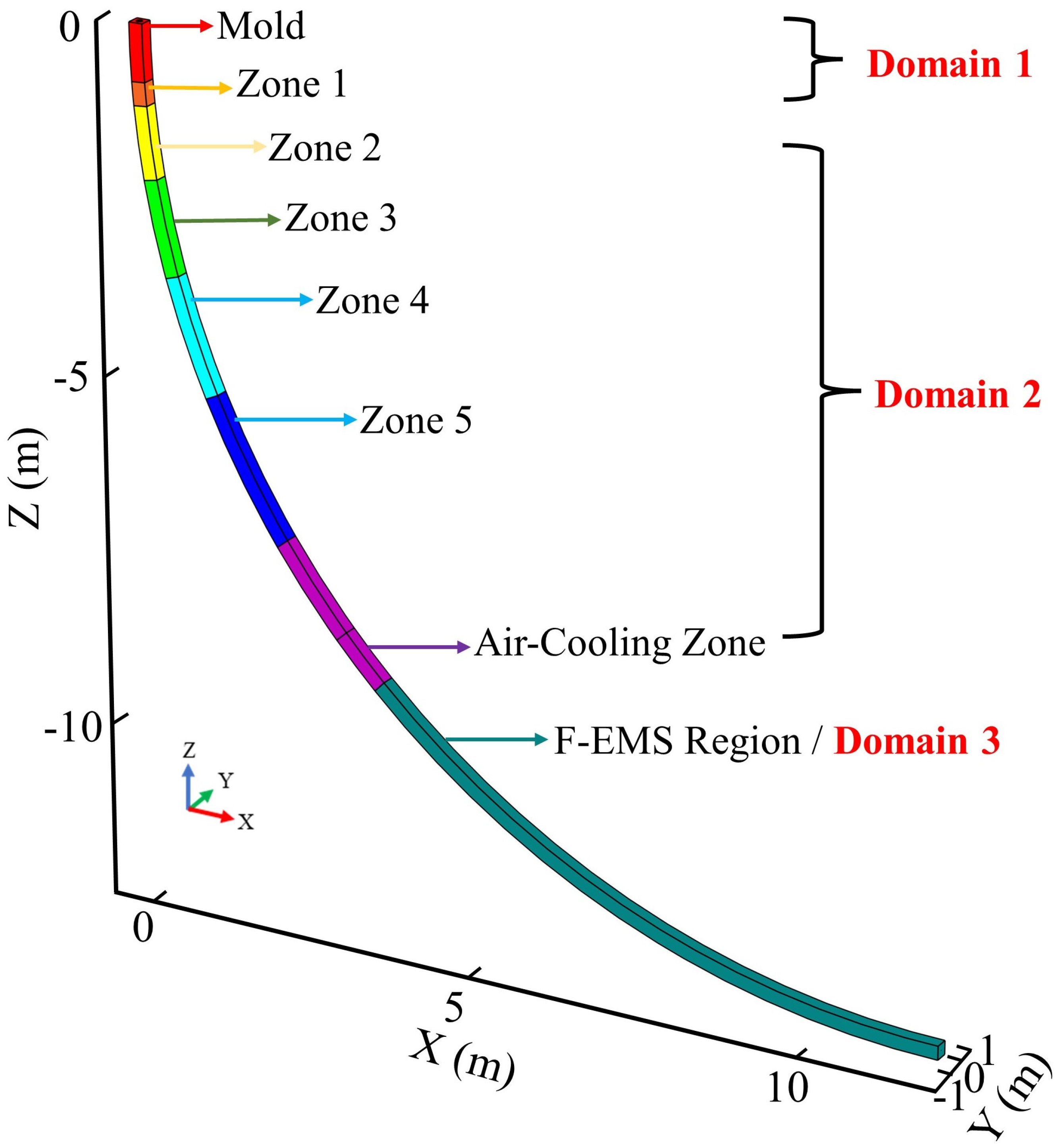
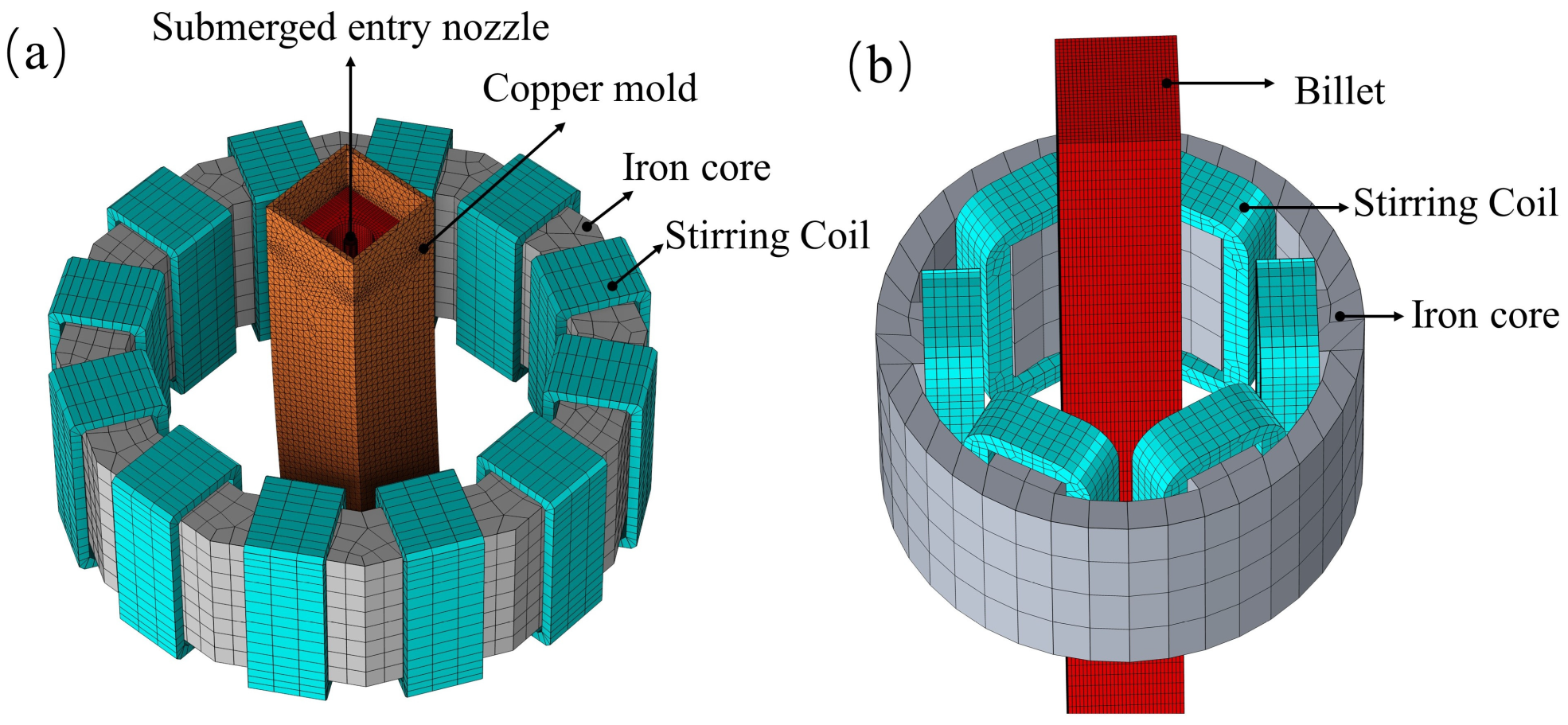
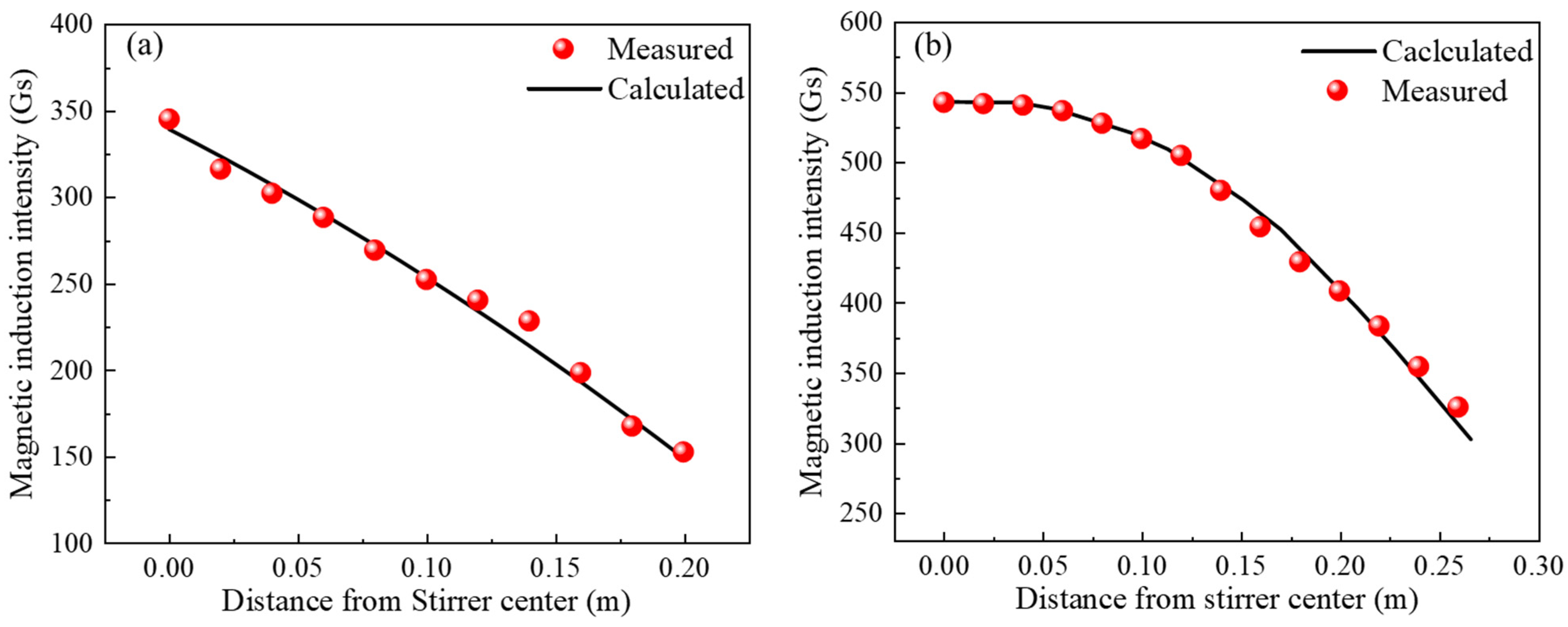

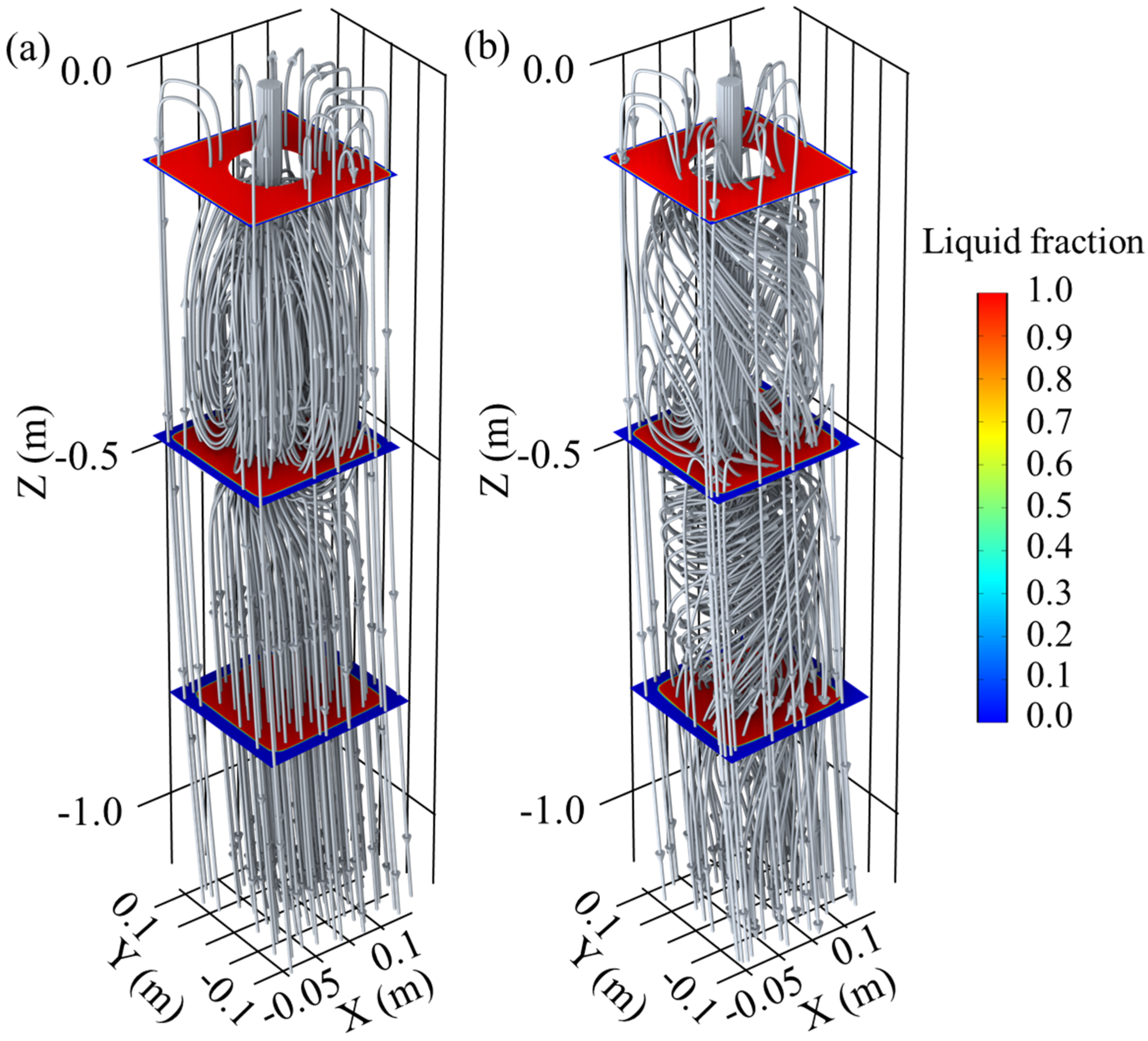
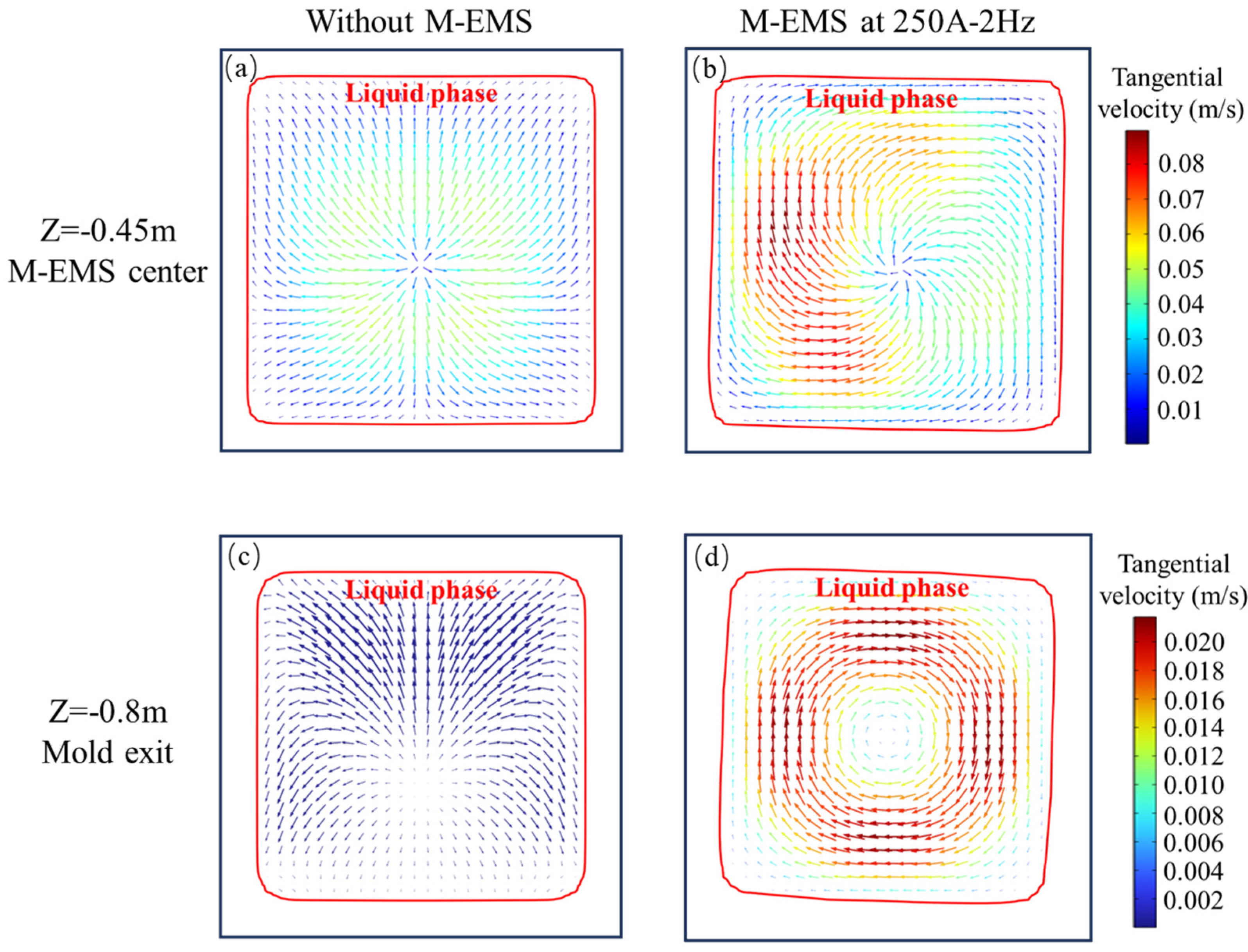
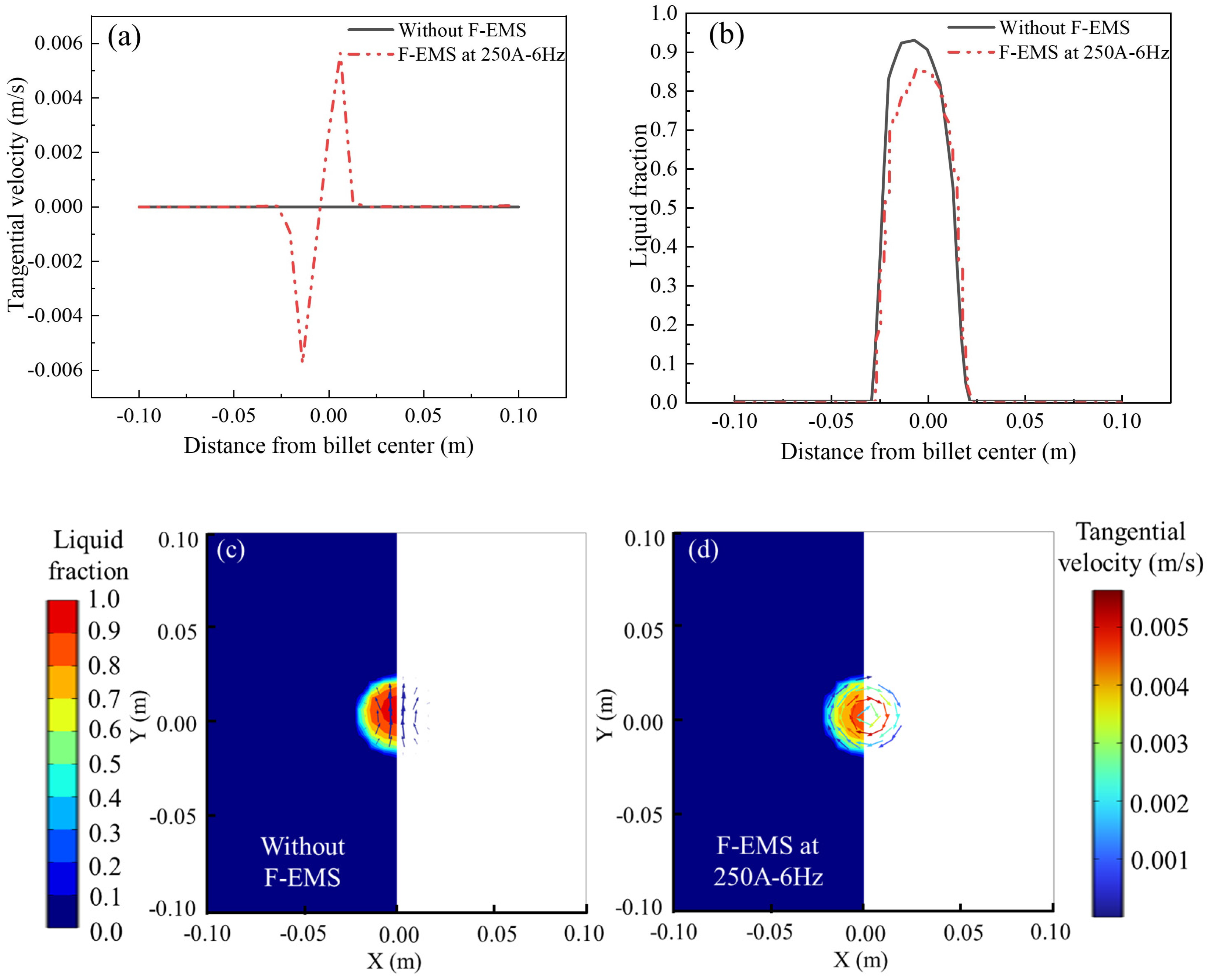
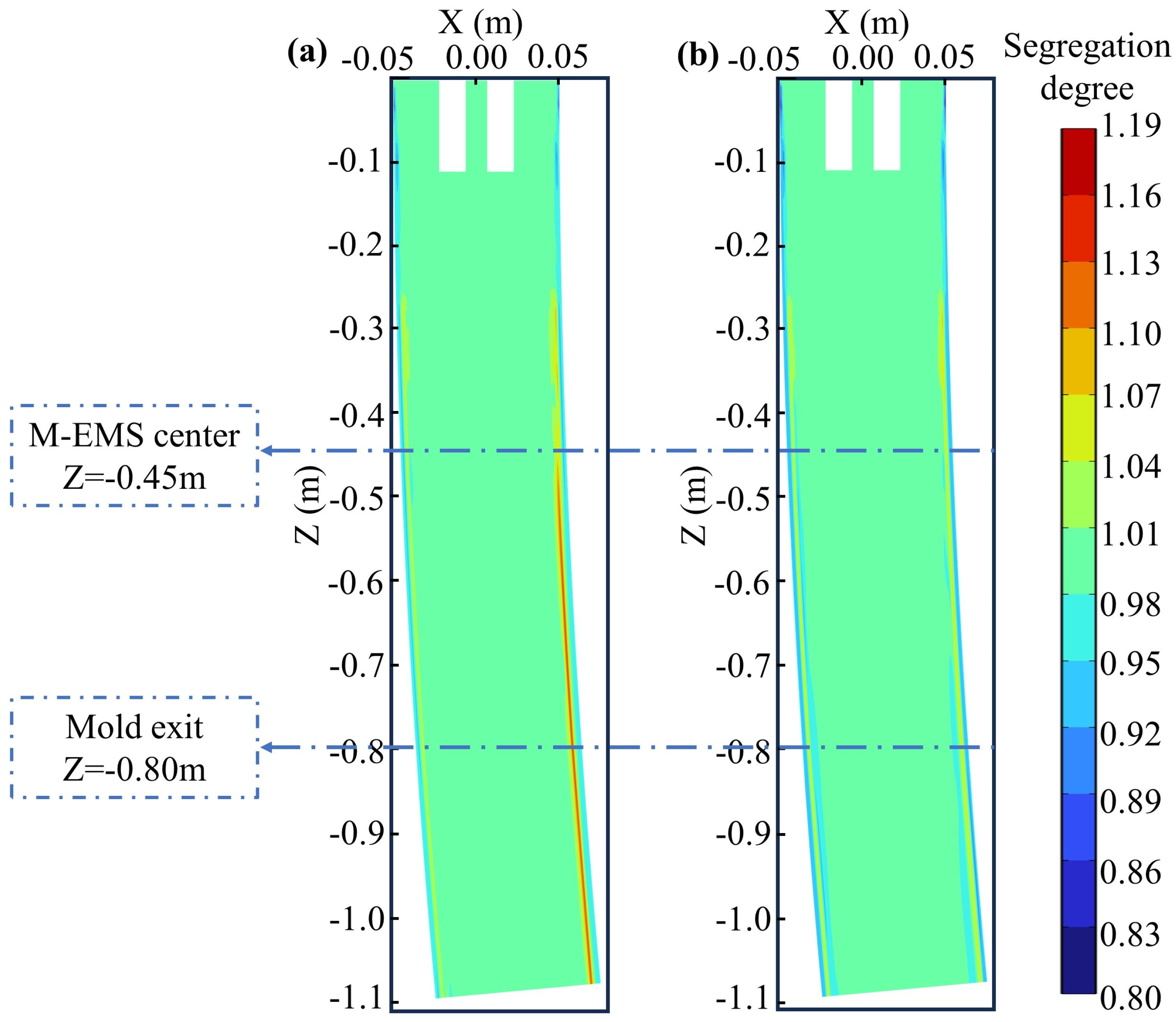
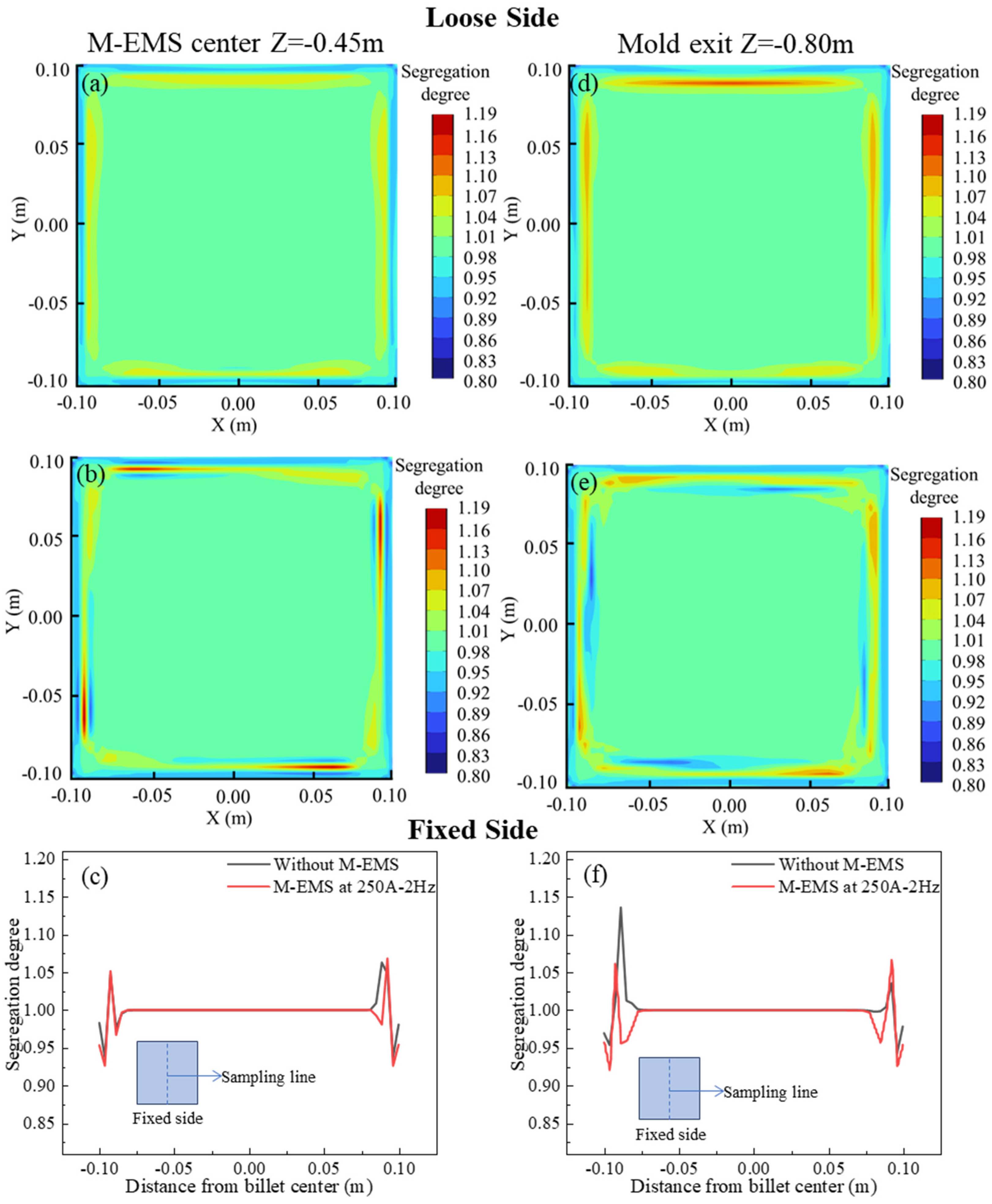
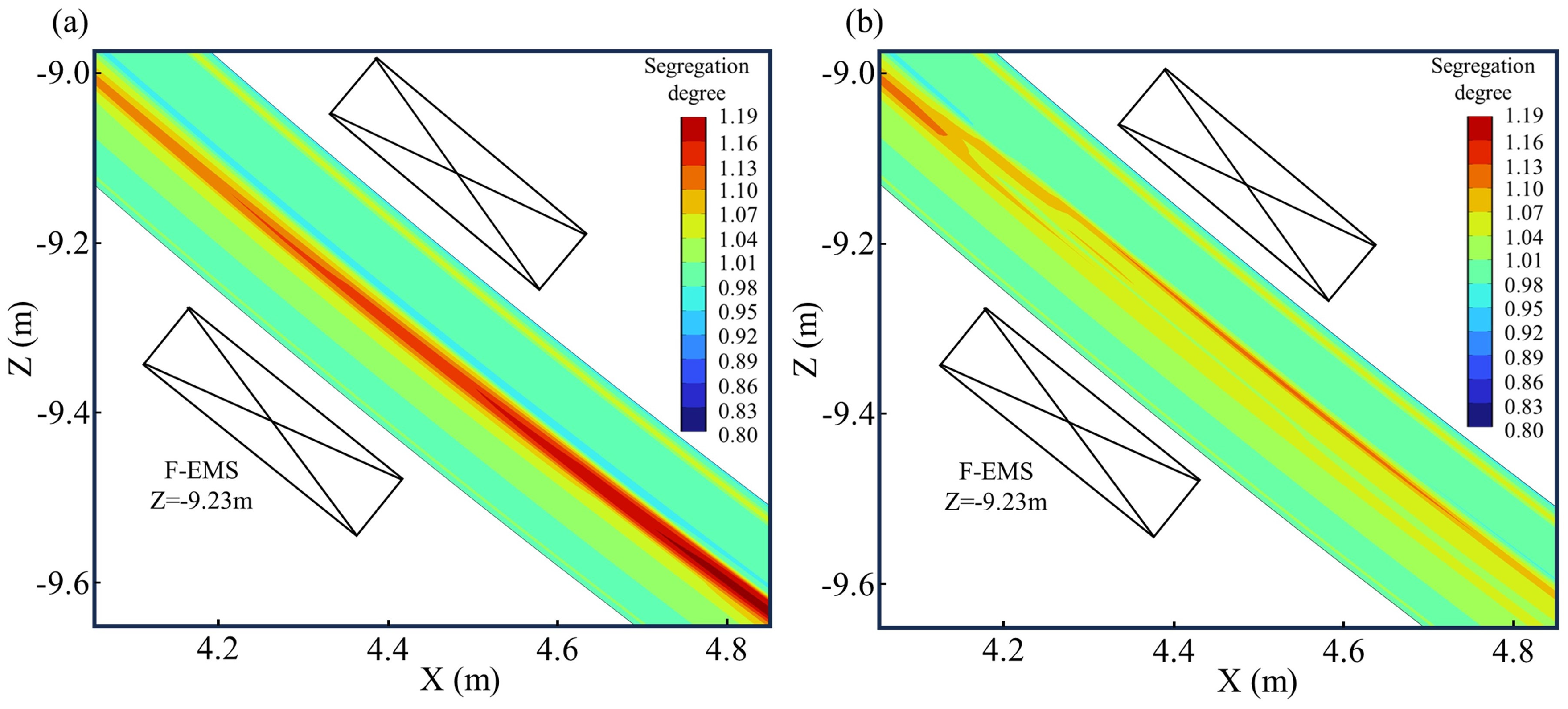
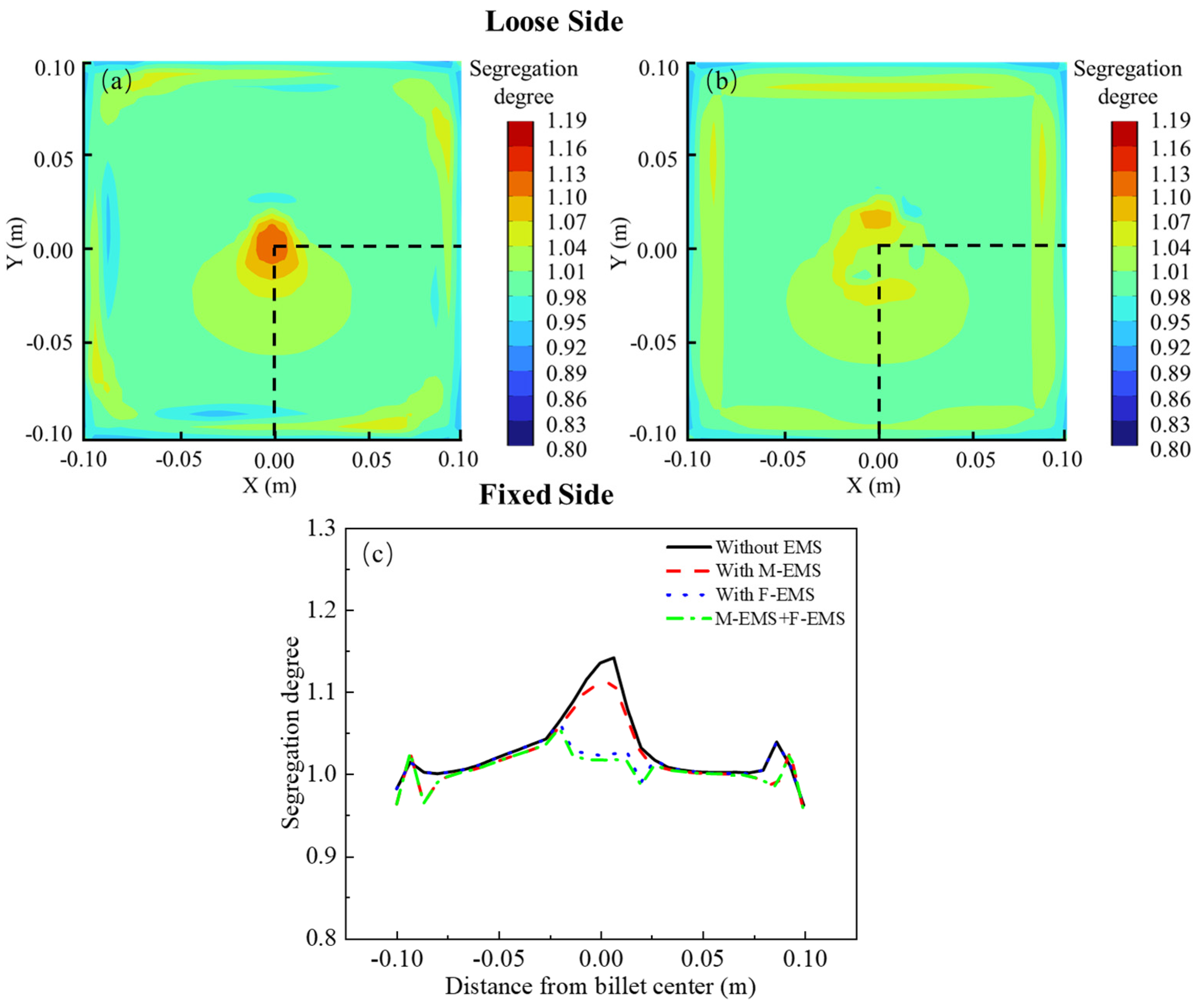

| Parameters | Value |
|---|---|
| Billet cross-sectional dimensions | 200 mm × 200 mm |
| Continuous casting machine arc radius | 12 m |
| Mold effective length | 0.8 m |
| SEN inner diameter | 0.026 m |
| SEN outer diameter | 0.09 m |
| SEN depth | 0.11 m |
| Mold thickness | 0.01 m |
| Vertical distance from M-EMS to meniscus | 0.45 m |
| Vertical distance from F-EMS to meniscus | 9.23 m |
| Zone 1 | Zone 2 | Zone 3 | Zone 4 | Zone 5 | |
|---|---|---|---|---|---|
| Length (m) | 0.3 | 1.0 | 1.3 | 1.5 | 1.5 |
| Water flow rate (L/min) | 43.9 | 38.4 | 23.3 | 17.8 | 13.7 |
| Element | C | Si | Mn | S | P | Cr |
|---|---|---|---|---|---|---|
| Concentration (wt.%) | 0.17–0.23 | 0.17–0.30 | 0.35–0.65 | <0.035 | <0.035 | <0.25 |
| Parameter | Symbol | Value |
|---|---|---|
| Thermal conductivity of liquid phase (W/(m·K)) | 38 | |
| Thermal conductivity of solid phase (W/(m·K)) | 40 | |
| Density of the billet (kg/m3) | 7100 | |
| Viscosity (Pa·s) | 0.0035 | |
| Initial solute concentration of carbon (wt.%) | 0.20 | |
| Latent heat (kJ/kg) | 270 | |
| Solute expansion coefficient (1/wt.%) | 0.011 | |
| Thermal expansion coefficient (1/K) | 1.0 × 10−4 | |
| Diffusion coefficient in the liquid phase (cm2/s) | 0.0761exp(−134,557.44/RT) | |
| Diffusion coefficient in the solid phase (cm2/s) | 0.0052exp(−11,700/RT) | |
| Equilibrium distribution coefficient for carbon | 0.34 | |
| Specific heat of the liquid phase (J/(kg·K)) | 828.33 | |
| Specific heat of the solid phase (J/(kg·K)) | 722 | |
| Emissivity of the strand | 0.8 |
| Parameter | Value |
|---|---|
| Pouring temperature (K) | 1808–1818 |
| Casting speed (m/min) | 1.3–1.4 |
| Pouring carbon content (wt.%) | 0.19–0.21 |
| M-EMS operating parameters (A-Hz) | 250-2 |
| F-EMS operating parameters (A-Hz) | 250-6 |
Disclaimer/Publisher’s Note: The statements, opinions and data contained in all publications are solely those of the individual author(s) and contributor(s) and not of MDPI and/or the editor(s). MDPI and/or the editor(s) disclaim responsibility for any injury to people or property resulting from any ideas, methods, instructions or products referred to in the content. |
© 2024 by the authors. Licensee MDPI, Basel, Switzerland. This article is an open access article distributed under the terms and conditions of the Creative Commons Attribution (CC BY) license (https://creativecommons.org/licenses/by/4.0/).
Share and Cite
Feng, Z.; Zhang, G.; Li, P.; Yan, P. Numerical Simulation of Fluid Flow, Solidification, and Solute Distribution in Billets under Combined Mold and Final Electromagnetic Stirring. Materials 2024, 17, 530. https://doi.org/10.3390/ma17020530
Feng Z, Zhang G, Li P, Yan P. Numerical Simulation of Fluid Flow, Solidification, and Solute Distribution in Billets under Combined Mold and Final Electromagnetic Stirring. Materials. 2024; 17(2):530. https://doi.org/10.3390/ma17020530
Chicago/Turabian StyleFeng, Zhenhua, Guifang Zhang, Pengchao Li, and Peng Yan. 2024. "Numerical Simulation of Fluid Flow, Solidification, and Solute Distribution in Billets under Combined Mold and Final Electromagnetic Stirring" Materials 17, no. 2: 530. https://doi.org/10.3390/ma17020530
APA StyleFeng, Z., Zhang, G., Li, P., & Yan, P. (2024). Numerical Simulation of Fluid Flow, Solidification, and Solute Distribution in Billets under Combined Mold and Final Electromagnetic Stirring. Materials, 17(2), 530. https://doi.org/10.3390/ma17020530







